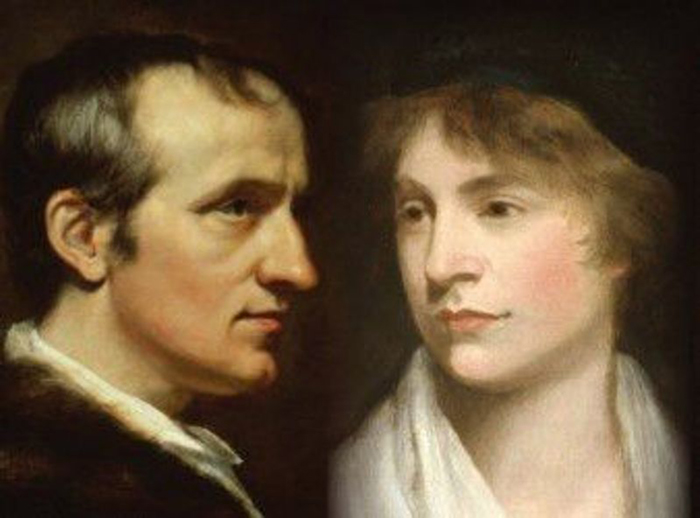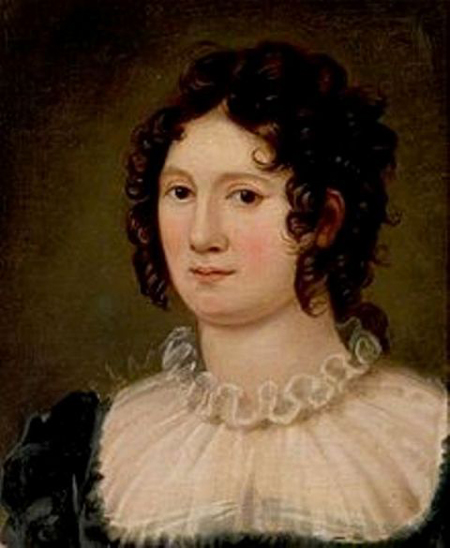
Percy Bysshe Shelley (4 August 1792– 8 July 1822), one of the major English romantic poets, was a born romantic. He was expelled from Oxford, on 28 August 1811, for anonymously publishing a pamphlet titled ‘The Necessity of Atheism’, and four months after that, the 19-year-old Percy, heartbroken after the failure of his romance with his cousin, Harriet Grove, eloped to Scotland with the 16-year-old Harriet Westbrook. Harriet was the younger daughter of a London tavern owner and a student at the same boarding school as Shelley's sisters. Harriet was very close to her 28-year-old sister Eliza, who encouraged her sister’s infatuation with Shelley, the future baronet. She pretended to disapprove the affair, but secretly encouraged the elopement.
Harriet Westbrook was intelligent and pretty and by accounts, she tried to be a worthy companion and supported Percy’s artistic pursuits. But, she was without the real gifts of intellectual curiosity to match his interests. She was not good enough for Percy and she could not make him happy. Percy’s dream of life with his lady love was rudely shattered when he discovered that Harriet was just an ordinary girl, well below his level of intellectuality. Increasingly, he became unhappy with his factual and prosaic conjugal life and especially resented the influence of Eliza, who discouraged Harriet from breastfeeding their baby daughter. Percy felt himself deprived and his longing for more intellectual female companionship led him to spend more time away from home, studying Italian with Cornelia Turner and visiting the home and bookshop of William Godwin. As Eliza and Harriet moved back with their parents, Shelley became more and more involved with the family of Godwin.

Godwin had three beautiful and highly educated daughters in his family. Fanny Imlay was the illegitimate daughter of his first wife, the feminist writer, Mary Wollstonecraft, while Claire Clairmont was the illegitimate daughter of his much younger second wife, Mary Jane Clairmont. Godwin’s daughter with his first wife, born on 31 August 1797, was named after her mother, Mary Wollstonecraft Godwin.
Percy fell in love with Mary as soon as he met her. In 1814, he finally deserted a pregnant Harriet and left for Switzerland with Mary, who was only 16. Along with them, they took another sixteen old Claire, as she was accomplished and fluent in French language. At sixteen Claire Clairmont was a vivacious, voluptuous and an attractive brunette with a good singing voice and a hunger for recognition. In fact, she helped her stepsister's secret meetings with Percy, who had professed a belief in free love.

However, Fanny Imlay was ignored by the trio and she was not invited to join them. Poor Fanny was left alone to suffer at home as she was also in love with Percy. While in Europe, Percy, Mary and Claire travelled a lot, walked all across France and Switzerland and enjoyed reading aloud the works of Shakespeare, Rousseau and Mary’s mother, Mary Wollstonecraft.
They returned to England after six weeks, but left the country again in 1816, for another trip to Switzerland. This tour was actually, prompted by Claire, who in competition with her sister, had initiated a liaison with Lord Byron the previous April, just before his self-exile on the continent. Claire was aware that, Byron's interest in her had waned, so she used the opportunity of introducing him to Mary and Shelley to act as bait to lure him to Geneva.

In the month of June 1816, Byron and his friend John William Polidori, an English writer and physician, arrived at the Villa Diodati, on the shore of Lake Geneva, Switzerland, where they were joined by Percy, Mary and Claire.
That summer of 1816 was extremely stormy and wet. The depressing wet weather along with the hostile summer and the incessant rainfall confined the party for days together in the house. As they had nothing better to do, they took to relating eerie stories and read aloud from ‘Fantasmagoriana’, a French collection of horror stories. On the evening of June 17th, they told more ghost stories and Byron recited lines from Coleridge’s Christabel, whereupon, in the ensuing silence, Shelley suddenly screeched, threw his hands to his head and ran from the room. Polidori reacted quickly, threw water on his face and gave him ether. Later, Percy claimed to have seen a vision of a woman with eyes instead of nipples, which had horrified him. Sitting around a log fire, Byron then proposed that they each write a ghost story. Those stormy evenings actually inspired those great writers to compose some of the greatest stories ever written. In the two following years, Polidori completed his prose fiction ‘The Vampyre’, Percy wrote ‘Mont Blanc’, and encouraged Byron to complete ‘Don Juan’, while Mary wrote the most outstanding and disturbing ‘Frankenstein’.
During that time Claire Clairmont and Byron had an affair. In fact, Claire pursued Byron and after their return to England, she had an illegitimate daughter with Byron.
However, Fanny Imlay was dejected and depressed. She felt deprived, ignored and insulted. She was unable accept her exclusion from her sisters and Percy’s intimate relationship and ultimately committed suicide. On the morning of 10 October, she was found dead in a room at aninn in Swansea, along with a suicide note and a bottle containing tincture of opium.
On the 10th of December, within two months of the tragic end of Fanny Imlay, Percy Shelley's wife, Harriet, was discovered drowned in the Serpentine, a lake in Hyde Park, London, while she was in an advanced state of pregnancy. Both the suicides were successfully hushed up. Percy, fully supported by Mary, was keen to assume the custody of his two children by Harriet, but the family of Harriet was strongly opposed it. At the instance of his lawyers, to improve his position in the legal case, Percy ultimately married Mary Godwin on the 30th day of December 1816 at St Mildred's Church, London. During that time, Mary was pregnant again. But, in March of that year, the decision of the Chancery Court made Percy frustrated, as the Court ruled him morally unfit to assume custody of his children and later placed them with a clergyman's family.

On 11 March 1818, Percy, Mary and Claire left England for Italy. During that time, Byron was residing in Venice and they had the intention to hand over Claire's daughter, Allegra, to her father Byron. Byron, in the mean time had lost his interest about sharp-tongued Claire, but agreed to raise the child, so long as Claire had nothing more to do with her. But, the Italian adventure became a disastrous for the couple, when they lost both their children - Clara, in September 1818 in Venice, and William, in June 1819 in Rome.
Italy provided them, along with Byron and other exiles, a political freedom unattainable at home. During those days, Percy and Mary moved between various Italian cities. In late 1818 they were living in Florence. Then they moved to Pisa. Shelley completed ‘Prometheus Unbound’ in Rome and during the summer of 1819 in Leghorn (modern Livorno, an Italian port city on the west coast of Tuscan), completed a tragedy, ‘The Cenci’, based on a case of incestuous rape and patricide in sixteenth-century Rome. In 1820, Shelley came to know about the illness of John Keats and invited him by a letter to join them at his place in Pisa, for recuperation. Keats gladly accepted the invitation, but it never materialised. After his untimely death, Shelley wrote the elegy ‘Adonais’ in 1821.

Less than a month before his thirtieth birthday, Shelley drowned in a sudden storm in the Gulf of Spezia on the 8th day of July 1822, while returning from Leghorn to Lerici in his schooner, the ‘Don Juan’. In fact, the open boat did not capsize, it sank. Mary Shelley in her ‘Note on Poems of 1822’ (1839) mentioned that, the design of the boat had a defect and it was not at all seaworthy. However, the Don Juan was very much seaworthy, it sank due to a severe storm and poor seamanship of the three men on board. On board, Shelley was accompanied by two other Englishmen. One of them was a retired naval officer, Edward Ellerker Williams and the other was a helping hand, Charles Vivien. The boat was found 16km offshore, and it was suggested that one side of the boat had been rammed by a much stronger vessel. The life saving raft was not used and was attached to the boat as usual. The other bodies were found completely clothed, including the shoes. Shelley's body was found separately on the shore and was cremated on the beach near Viareggio. A small book of poetry by Keats was found in Shelley's pocket. In his account of the recovery of Shelley's body, Edward John Trelawny, a common friend of Percy and Byron, recorded that, his shirt was partly drawn over the head, as if he was in the act of taking it off. One of his shoes was missing and the uncovered part of his body was fleshless. By the time the search party returned to the beach for the cremation, the body was even further decomposed. In his account of the cremation, he also mentioned that, Byron was simply became unnerved and left the beach, as he could not face the shocking scene any more.

At the peak of his fame as a poet, Shelley lost his life before he was thirty and Mary spent the rest of her life unsupported by his family and editing her husband’s work, earning money to support their son to come up in life and lamenting her own failure to become something great and good.
Though Claire Clairmont's biographers did not find any hard evidence, but Claire may have been sexually involved with Percy at different periods. One of their friends, Thomas Jefferson Hogg, often referred Mary and Claire as ‘Shelley and his two wives’, which was recorded by Claire in her own journal. More than Mary, Claire ardently supported Shelley's theories about free love, communal living, and the right of a woman to choose her lovers and initiate sexual relationships outside the institutional marriage. She had really formed a close friendship with Shelley and it has occasionally been suggested that she was the mother of a daughter fathered by Percy Shelley.
Devastated after Shelley's death, Mary returned to England and paid for Claire to travel to her brother's home in Vienna. Claire stayed there for a year, before relocating to Russia, where she worked as a governess from 1825 to 1828.She returned to England in 1836, worked as a music teacher and cared for her mother when she was dying. After the death of her mother, Claire moved to Pisa in 1841. Percy Shelley had left her £12,000 in his will, which she finally received in 1844. She also carried on a bitter battle of correspondence with her stepsister, until Mary died in 1851.
Claire Clairmont died in Florence on 19 March 1879, at the age of eighty. She outlived all the members of Shelley's circle, which include Percy and the three sisters.

At the behest of Shelley's daughter-in-law, Lady Shelley, sculptor Edward On slow Ford created a reclining marble statue of Shelley's body, depicted as washed up on the shore. The design of the statue was drawn specifically from the death scene in ‘Adonais’. Initially the statue was intended to be located in the Protestant Cemetery in Rome where Shelley is buried. However, eventually it ended up in Shelley Memorial at University College, Oxford, from where he was expelled in 1811.

